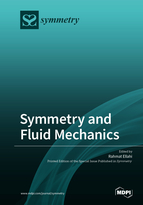Symmetry and Fluid Mechanics
A special issue of Symmetry (ISSN 2073-8994). This special issue belongs to the section "Mathematics".
Deadline for manuscript submissions: closed (31 July 2019) | Viewed by 93782
Special Issue Editor
2. Chair Professor, Center for Modeling & Computer Simulation, Research Institute, King Fahd University of Petroleum & Minerals, Dhahran 31261, Saudi Arabia
3. Department of Mathematics, International Islamic University, Islamabad 44000, Pakistan
Interests: nanofluid; non-newtonian fluid; heat and mass transfer; porosity; MHD; peristaltic; blood flow
Special Issues, Collections and Topics in MDPI journals
Special Issue Information
Dear Colleagues,
This Special Issue invites you to contribute your original research work and review articles on “Symmetry and Fluid Mechanics” that either advances the state-of-the-art of mathematical methods, theoretical, or experimental studies, or extends the bounds of existing methodologies to new contributions related to the symmetry, asymmetry, and lie symmetries of differential equations proposed as mathematical models in fluid mechanics to address current challenges. We hope that this Issue will provide an overall picture and up-to-date findings to readers of the scientific community that ultimately benefit the industrial sector regarding its specific market niches and end users.
Scope: Potential topics dealing with the following subheadings are deemed suitable for publication but are not limited to
- The symmetry method, the lie group, homotopy perturbation, homotopy analysis, perturbative series, differential transform, integral transform, numerical simulations and approximate, finite element, volume and difference methods, and other new technologies;
- Newtonian and non-Newtonian fluids;
- Nanofluids and particle shape effects;
- Convective heat and mass transfer;
- Steady and unsteady flow problems;
- Multiphase flow simulations;
- Fractional order differential equations;
- Thermodynamics;
- Physiological fluid phenomena in biological systems.
Prof. Dr. Rehmat Ellahi
Guest Editor
Manuscript Submission Information
Manuscripts should be submitted online at www.mdpi.com by registering and logging in to this website. Once you are registered, click here to go to the submission form. Manuscripts can be submitted until the deadline. All submissions that pass pre-check are peer-reviewed. Accepted papers will be published continuously in the journal (as soon as accepted) and will be listed together on the special issue website. Research articles, review articles as well as short communications are invited. For planned papers, a title and short abstract (about 100 words) can be sent to the Editorial Office for announcement on this website.
Submitted manuscripts should not have been published previously, nor be under consideration for publication elsewhere (except conference proceedings papers). All manuscripts are thoroughly refereed through a single-blind peer-review process. A guide for authors and other relevant information for submission of manuscripts is available on the Instructions for Authors page. Symmetry is an international peer-reviewed open access monthly journal published by MDPI.
Please visit the Instructions for Authors page before submitting a manuscript. The Article Processing Charge (APC) for publication in this open access journal is 2400 CHF (Swiss Francs). Submitted papers should be well formatted and use good English. Authors may use MDPI's English editing service prior to publication or during author revisions.






